Tabular conservation prioritization with prioritizr SyncroSim
This tutorial provides an overview of working with prioritizr in SyncroSim Studio to create and solve a tabular conservation problem. Here, you will review a pre-configured library that uses data derived from the prioritizr R package documentation. It covers the following steps:
Step 1. Creating a prioritizr SyncroSim library
In SyncroSim, a library is a file with extension .ssim that stores all the model’s inputs and outputs in a format specific to a given package. To load the pre-configured library:
1. Open SyncroSim Studio.
2. Select File > New > From Online Template….

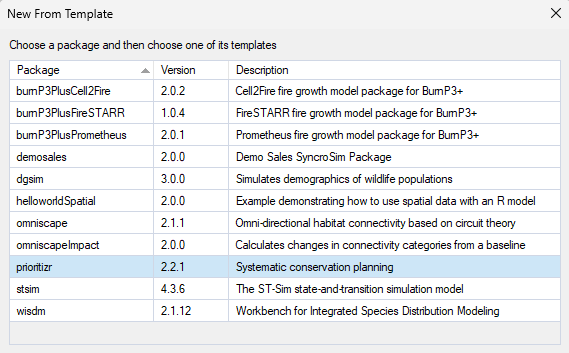
b. From the list of template libraries, select the Tabular Formulation Example.
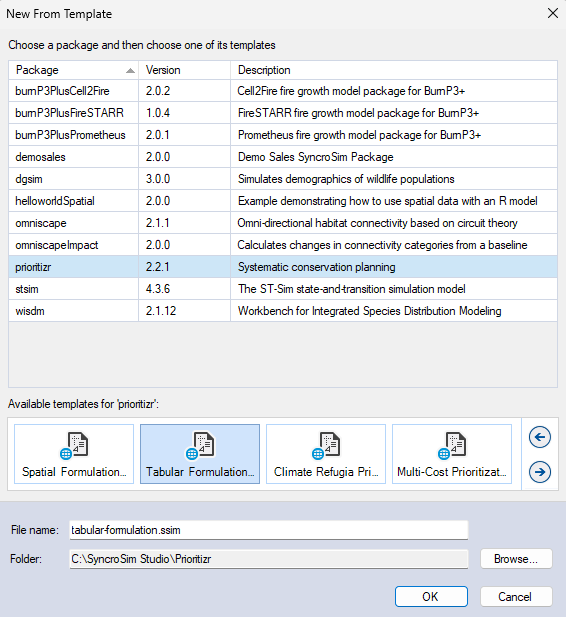
c. If desired, you may edit the File name, and change the Folder by clicking on the Browse button.
d. When done, click OK.
A new library has been created based on the selected template, and SyncroSim will have automatically opened and displayed it in the Explorer window.
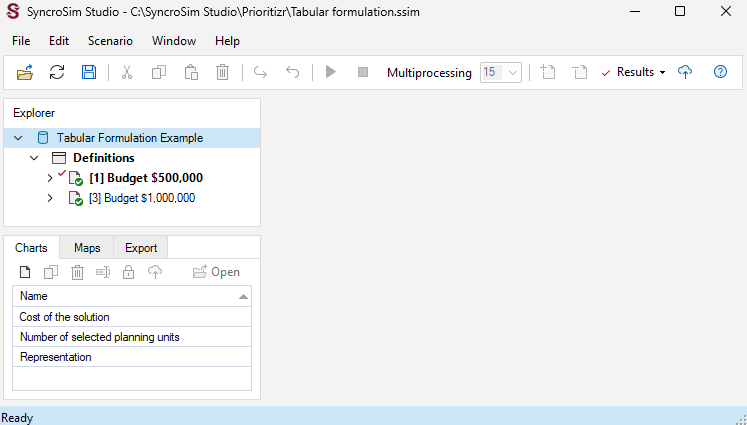
3. Double-click on the library name, Tabular Formulation Example, to open the library properties window. You may also right-click on the library name and select Open from the context menu.
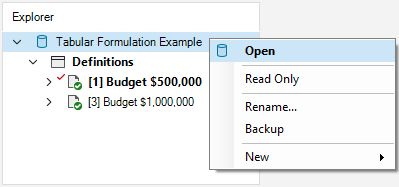
4. The Summary datasheet contains the metadata for the library.
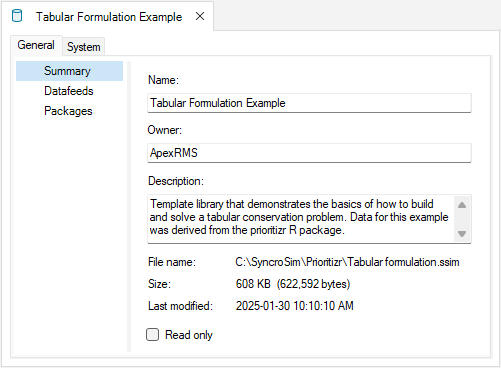
5. Next, navigate to the System tab, Options node, General datasheet, and make sure Use conda is disabled.
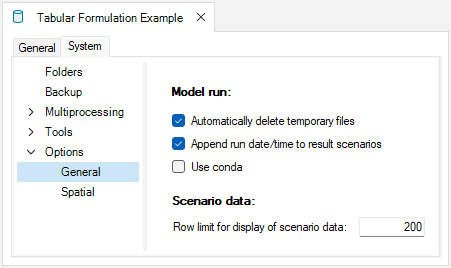
6. Close the library properties window.
Next, you will review the target feature data for the conservation prioritization problem.
7. From the Explorer window, right-click on Definitions and select Open from the context menu.
8. Under the Prioritizr tab, select the Features datasheet, which lists the variables that will be taken into account in the prioritization process. This datasheet was automatically populated once the first scenario was run.
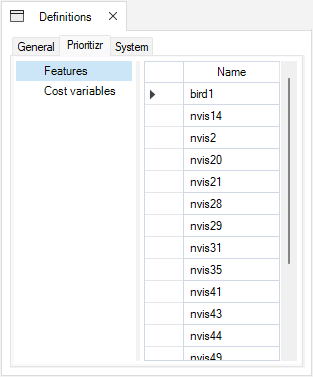
Now, you will review the inputs for the Budget $500,000 scenario. In SyncroSim, scenarios contains the model inputs associated with a model run.
9. In the Explorer window, select the pre-configured scenario Budget $500,000 and double-click it to open its properties. You may also right-click on the scenario name and select Open from the context menu.
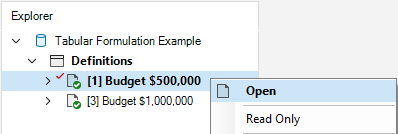
10. Navigate to the Pipeline datasheet. Pipeline stages call on a transformer (i.e., script) which takes the inputs from SyncroSim, runs a model, and returns the results to SyncroSim. Under the Stage column, note that a single pipeline stage is set called Base Prioritization.

11. Navigate to the Prioritizr tab and expand the Base Prioritization > Data nodes.
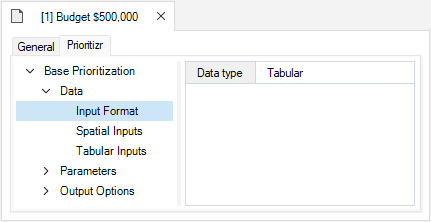
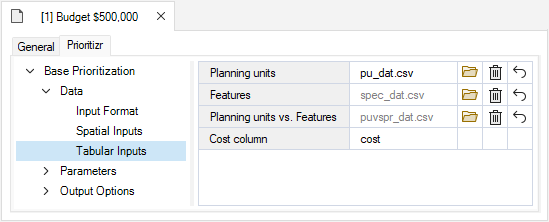
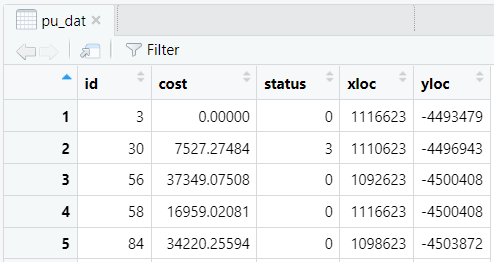
ii. Features – a data table listing the feature variables. These are listed under the column name, with an associated ID. The other columns displayed here are optional fields and not used in this example.
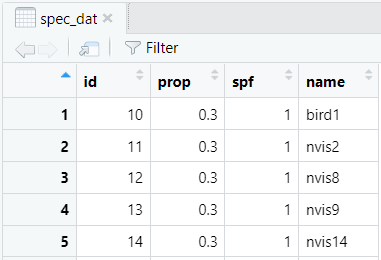
iii. Planning units vs. Features – a data table listing, for each planning unit (under the pu column), the value (under the amount column) associated with each feature variable (under the species column).
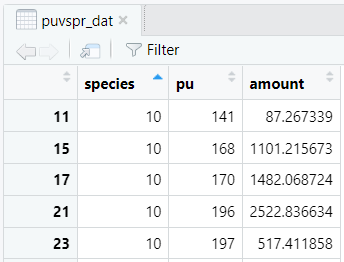
12. Expand the Parameters node.
ii. Budget – this number represents the total cost of the prioritization. Specifically, this value is set to $500,000.
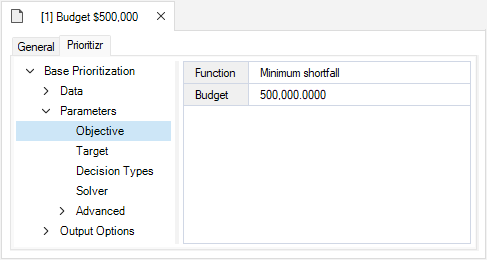
ii. Amount – specifies the desired level of feature representation in the study area. In this example, it is set to 0.2, so that each feature would ideally have 20% of its distribution covered by the prioritization.
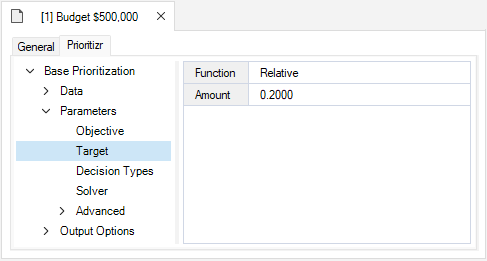
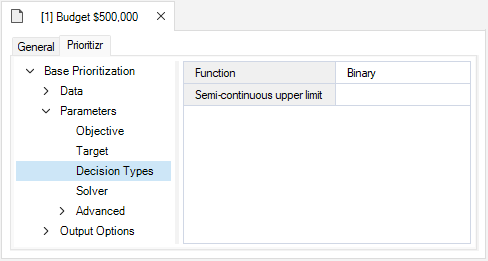
ii. Gap – represents the gap to optimality, and is set to a default value of 0.1. This gap is relative and expresses the acceptable deviance from the optimal objective. In this example, a value of 0.1 will result in the solver stopping when it has found a solution within 10% of optimality.
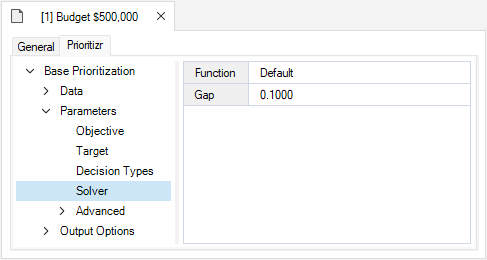
13. Expand the Output Options node and open the Performance datasheet to review the following inputs set to Yes:
ii. Cost summary – calculates the total cost of the solution to the conservation planning problem.
iii. Feature representation summary – calculates the amount of each feature covered in the solution to the conservation planning problem.
iv. Target coverage summary – calculates how well feature representation targets are met by the solution to the conservation planning problem.
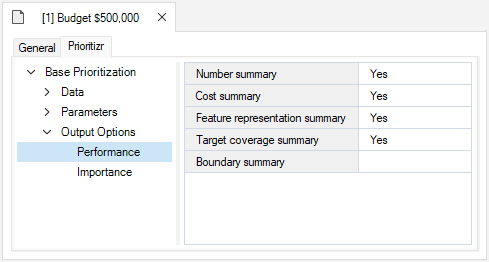
Step 2. Visualizing and comparing results across scenarios
The Tabular Formulation Example template library already contains the results for each scenario. Before exploring the additional scenario, you will view the main result for the Budget $500,000 scenario.
1. In the Explorer window, expand the Budget $500,000 > Results nodes to reveal the Budget $500,000 results scenario. This scenario contains the outputs of the model run, it is timestamped, and has a copy of all the input parameters. Double-click it to open its properties. You may also right-click on the result scenario name and select Open from the context menu.
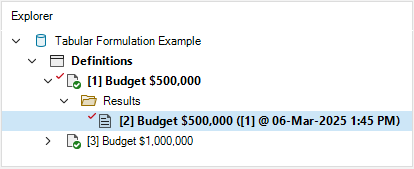
2. Navigate to the Prioritizr tab, expand the Results > Tabular nodes, and select the Solution datasheet to analyse the results table.
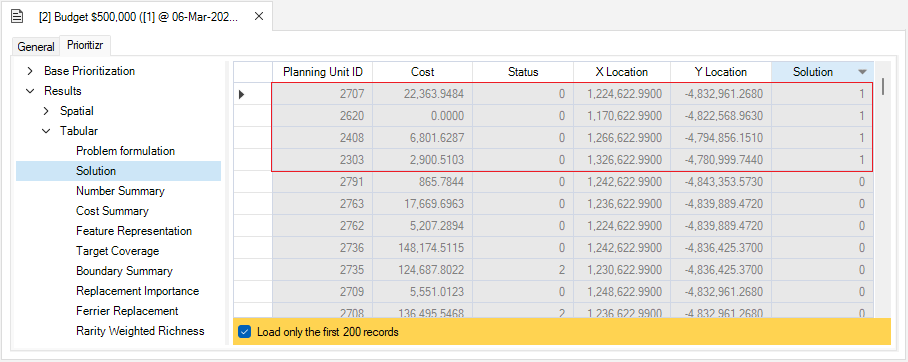
3. Close the tab and from the Explorer window, collapse the scenario node by clicking on the downward facing arrow beside the scenario name.
Now you will review the additional scenario and explore how it differs from the Budget $500,000 scenario.
4. In the Explorer window, select the pre-configured scenario Budget $1,000,000, and double-click it to open its properties. You may also right-click on the scenario name and select Open from the context menu.
5. Navigate to the Prioritizr tab, expand the Parameters node, and open the Objective datasheet. Here, the budget for the Budget $1,000,000 scenario is double that of the Budget $500,000 scenario. Note that all other inputs remain the same.
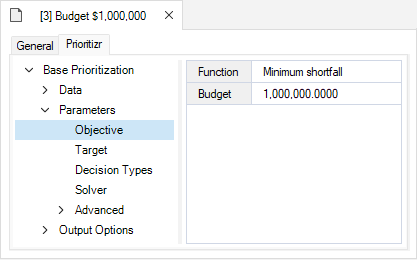
6. In the Explorer window, right-click on the Budget $1,000,000 scenario, and select Add to Results from the context menu.
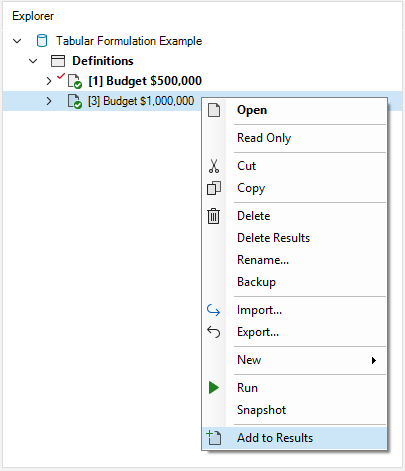
7. Navigate to the Charts tab, and double-click on the pre-configured Cost of the solution chart. Here, note the difference in solution cost matches the budget set in each scenario.
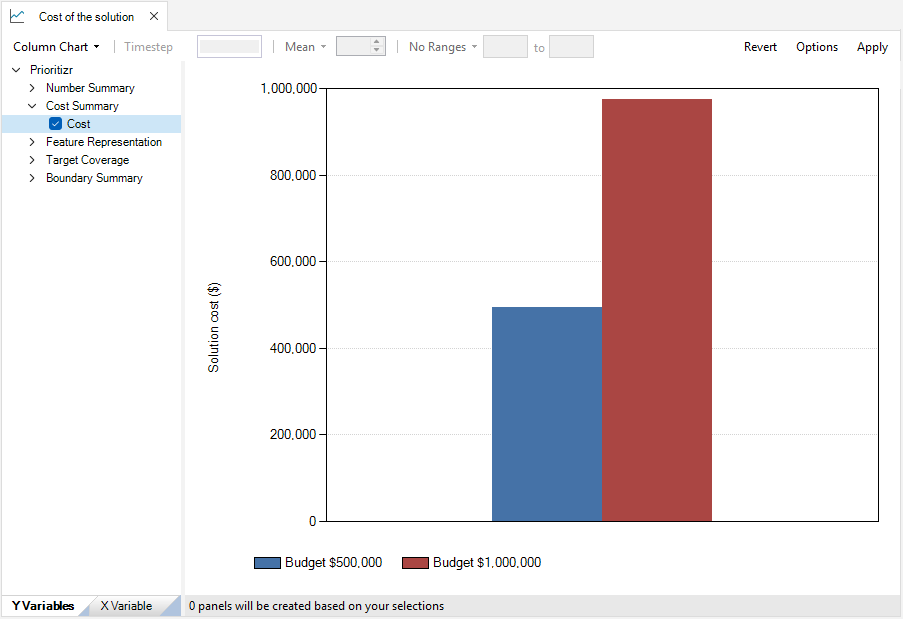
8. Next, double-click on the pre-configured Number of selected planning units chart. In this case, with a larger budget more planning units were covered by the solution.
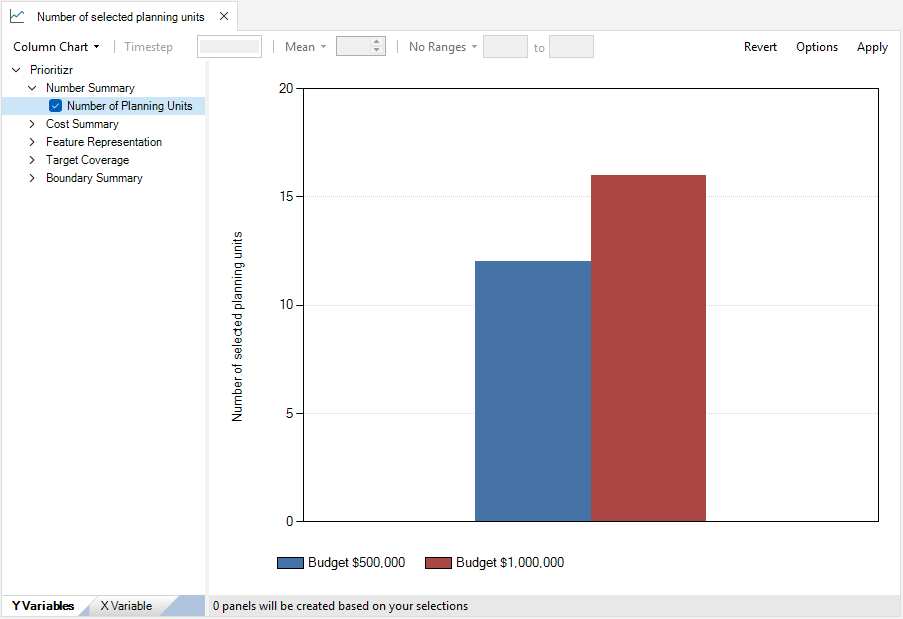
9. Now, double-click on the pre-configured Representation chart. The upper chart shows the proportion of each feature covered by the solution under the different scenarios. In turn, the bottom chart shows the respective deviation from the target coverage of 20%. The results indicate that an even larger budget is needed for the 20% target to be met.
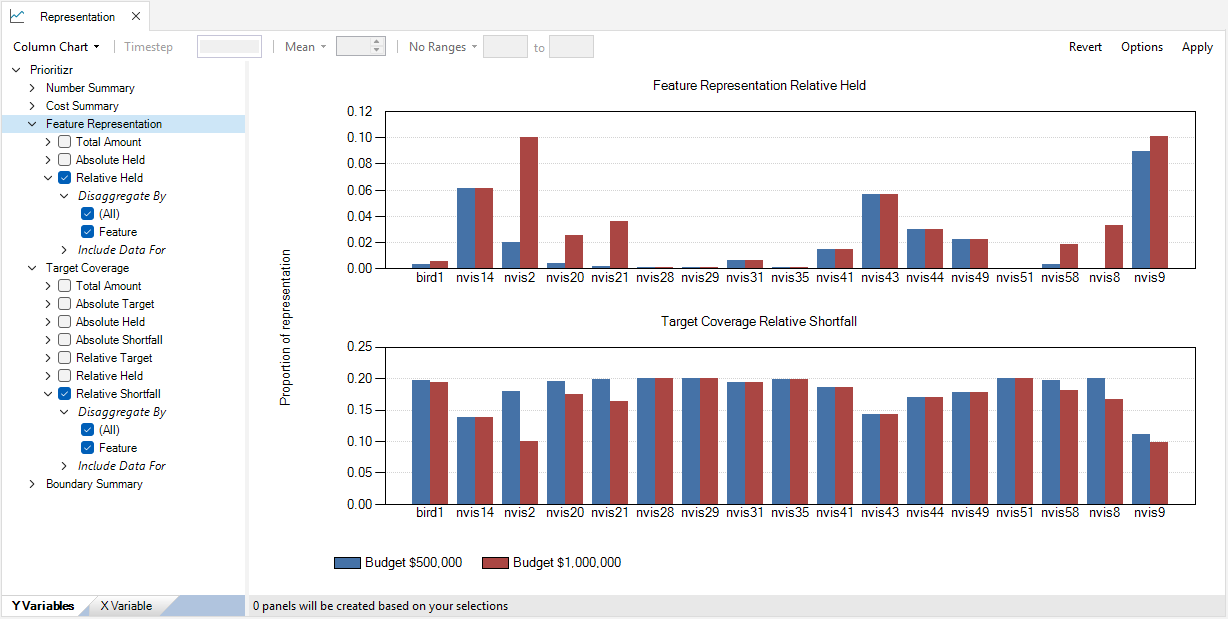
This tutorial demonstrated how prioritizr can be used to build tabular formulations of conservation problems. Next, to explore how to further customize a conservation problem with feature weights, see the next tutorial Climate refugia prioritization with prioritizr SyncroSim.